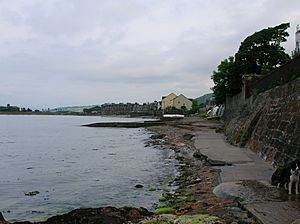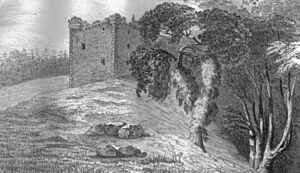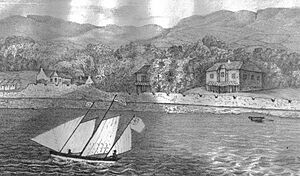Fairlie, North Ayrshire facts for kids
Quick facts for kids Fairlie
|
|
|---|---|
 Fairlie seafront looking towards Largs |
|
| Population | 1,490 (2020) |
| Council area | |
| Lieutenancy area |
|
| Country | Scotland |
| Sovereign state | United Kingdom |
| Post town | Largs |
| Postcode district | KA29 |
| Dialling code | 01475 |
| Police | Strathclyde |
| Fire | Strathclyde |
| Ambulance | Scottish |
| EU Parliament | Scotland |
| UK Parliament |
|
| Scottish Parliament |
|
Fairlie is a small village located in North Ayrshire, Scotland. It's a lovely place to live, sitting right by the sea.
Contents
Exploring Fairlie: Location and What It's Like
Fairlie is found on the eastern shore of the Firth of Clyde. From here, you can look across the water to the beautiful Isle of Arran and the smaller islands called the Cumbraes.
Today, Fairlie is mostly a place where people live and travel to work in other towns. There are not many businesses left in the village itself. You can still find the "Village Inn," which is a pub and restaurant, and a petrol station.
In 2001, a count of the population showed that 1,510 people lived in Fairlie.
Did you know that Fairlie House, located near Gatehead, Ayrshire in East Ayrshire, was named after the Fairlie family? This family originally lived in Fairlie village. Before being named Fairlie House, it was called Little Dreghorn.
Fairlie's Past: A Look at Its History
Early Days and Important Families
A long time ago, in the 12th century, a king named King David I of Scotland gave land to a Norman knight named Sir Richard de Morville. Richard became a very important person, known as the Lord High Constable of Scotland. He also became the lord of large areas like Cunninghame, Largs, and Lauderdale.
Over time, this big piece of land was divided among Richard's family and friends. By the 13th century, the land where Fairlie village now stands was owned by the de Ros (or Ross) family. The land to the north was held by the Boyle family, and the land to the south by the Sempill family.
The Fairlie Castle Story
One of the sons from the Ross family built a castle in the area. This family then took on the name Fairlie. They lived in Fairlie Castle until the 17th century. By the late 1800s, the castle was mostly in ruins. However, in 1999, it was sold to be turned into a home again!
Fairlie Castle looks a lot like other old castles in the area, such as Law Castle, Little Cumbrae Castle, and the tower of Skelmorlie Castle.
Other Important Estates
The land south of Fairlie Burn, which was owned by the Sempill family, was never part of the Fairlie family's land. This area is actually in the Parish of West Kilbride. Later, the Montgomerie family owned this estate, called Southannan. The original Southannan House or Castle was taken down in the 1700s, and the current house was built later.
To the north of Fairlie are the lands of Kelburn Castle. The Boyville (Boyle) family has lived at Kelburn since the 12th century. In 1703, a man named David Boyle was given the special titles of Viscount Kelburn and Earl of Glasgow.
Around 1850, one of the later Earls of Glasgow had a wall built around the Kelburn estate. This project helped give jobs to the poor people living nearby. The current Earl has done a lot to improve and develop the estate. Today, Kelburn is a popular country center that is open to the public. Many visitors come from all over to see it.
Fairlie as a Fishing and Weaving Village
Old records suggest that Fairlie first grew as a fishing village. It had a good, safe place for boats to anchor, which was used a lot in the 16th century.
Weaving also became important for the village's success, especially as Paisley shawls became popular. The small houses below Fairlie Castle, in an area called Burnfoot, were even known as Weaver's Row.
A bit further north was "middle row," also called Ferry Row. This is where the fishermen and ferrymen lived. You can still see parts of the old ferry quay today. This spot later became known as Knox's Rocks, named after Knox White, who rented out boats there in the 1920s and 1930s.
Even further north was "north row," a group of simple homes in the Bay Street area. Families living there often kept pigs and hens, and grew their own fruits and vegetables. Those who were better off might even have had a cow. Other things they needed were bought from traveling sellers. Sometimes, people would walk to Largs to visit Hyndman's market or the Colm's (Columba's) Day fair.
Roads and Shipping
In the 18th century, a main road called a turnpike was built from Greenock to Stranraer. This led to merchants and ship captains moving into Fairlie. The water channel between Fairlie and Cumbrae, known as Fairlie Roads, was a popular place for merchant ships to anchor. This was often done to avoid dangerous press-gangs in Greenock and to make it easier to avoid customs duties in Fairlie.
Over time, the old cottages were improved and some were made larger. New buildings were also put up. Some of the original buildings that still exist include Rockhaven (built around 1720, also known as the Ferry House), Fairlie Lodge, Beach House, Allanbank, Fairlie Cottage, and part of Brookside.
The Famous Fife Shipyard
In the late 1700s, John Fyfe came from Kilbirnie to start a business making carts in Fairlie. His son, William (who lived from 1785 to 1865), started the Fife & Son shipyard in Fairlie in 1803. William's grandson, William Fife III (1857–1944), made the shipyard famous around the world. He was a very talented designer and builder of sailing yachts.
Fairlie's Modern Role: MOD Base and Other Facilities
During World War II, in November 1940, the Royal Navy's ASDIC research center moved to Fairlie from Portland. They took over the Fife & Son shipyard. ASDIC was a type of sonar used to detect submarines.
The researchers at Fairlie also worked on other ways to fight submarines. In 1941, they developed something called the Fairlie Mortar. This weapon wasn't very successful, but it led to the creation of a much better weapon called the Squid.
After the war, a depot for boom defenses remained in Fairlie. There was even a plan to build an anti-submarine boom from Fairlie to Great Cumbrae, and then on to Bute.
In more recent years, some industrial and military projects have changed the village. The Hunterston B nuclear power station, the Hunterston deep sea shipping terminal, and a NATO base have all been built along the shoreline.
Fairlie Pier: A Look at Its Railway History
Fairlie Pier used to connect to ferry services on the Clyde and the Largs Branch railway line. However, it closed after its last ferry sailing in September 1971.
The other railway station in the village is still open today. It is served by trains on the Ayrshire Coast Line.
Views of Fairlie Bay and Village
See also
 In Spanish: Fairlie para niños
In Spanish: Fairlie para niños















